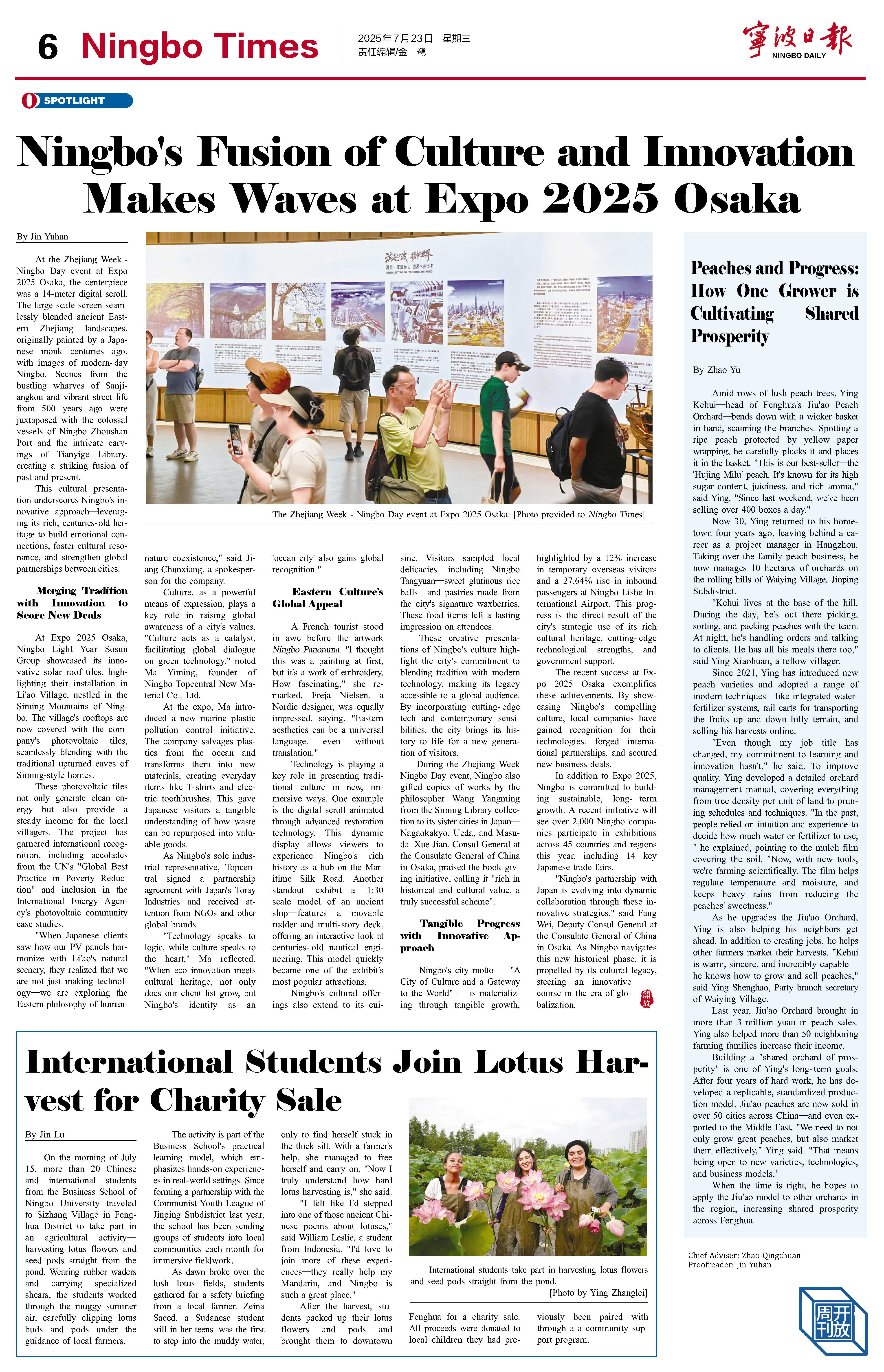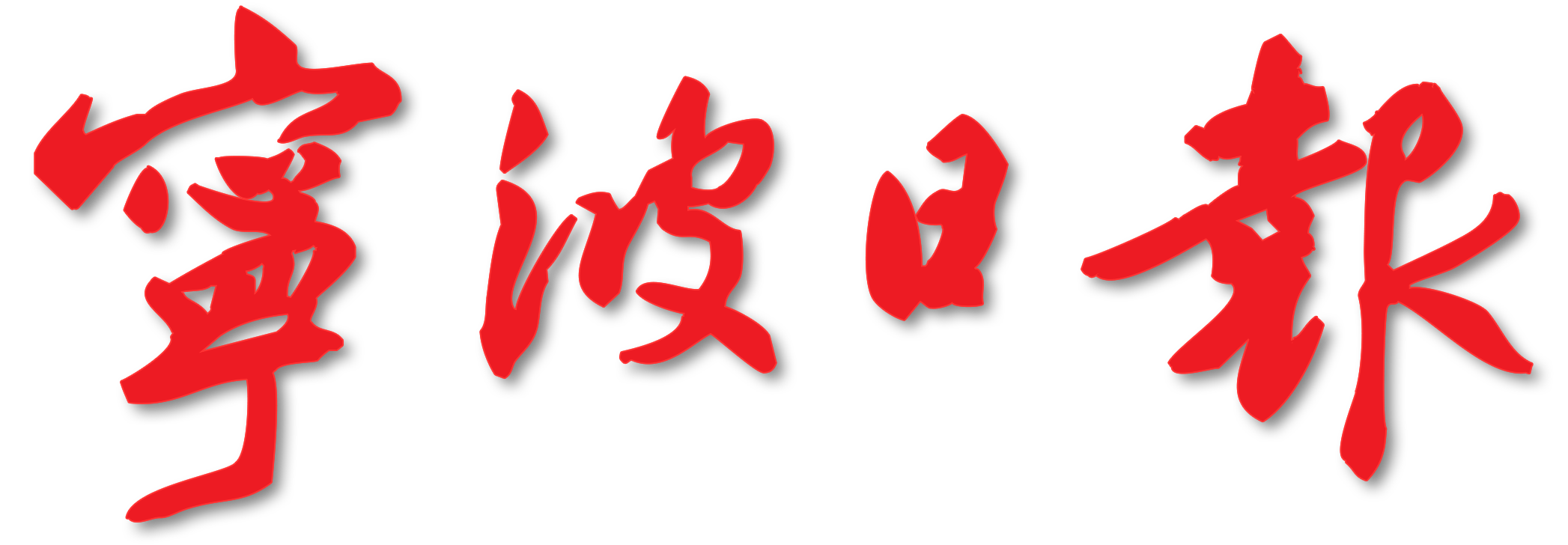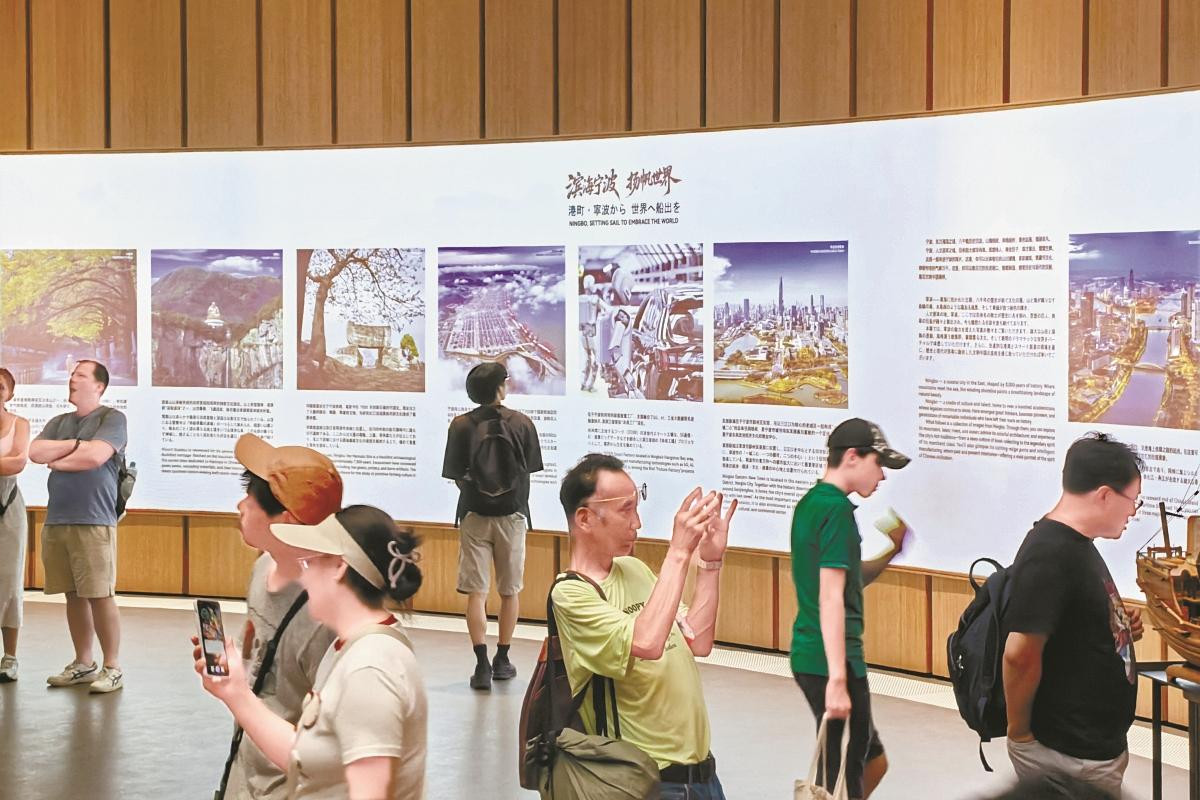By Jin Yuhan
At the Zhejiang Week - Ningbo Day event at Expo 2025 Osaka, the centerpiece was a 14-meter digital scroll. The large-scale screen seamlessly blended ancient Eastern Zhejiang landscapes, originally painted by a Japanese monk centuries ago, with images of modern-day Ningbo. Scenes from the bustling wharves of Sanjiangkou and vibrant street life from 500 years ago were juxtaposed with the colossal vessels of Ningbo Zhoushan Port and the intricate carvings of Tianyige Library, creating a striking fusion of past and present.
This cultural presentation underscores Ningbo's innovative approach—leveraging its rich, centuries-old heritage to build emotional connections, foster cultural resonance, and strengthen global partnerships between cities.
Merging Tradition with Innovation to Score New Deals
At Expo 2025 Osaka, Ningbo Light Year Sosun Group showcased its innovative solar roof tiles, highlighting their installation in Li'ao Village, nestled in the Siming Mountains of Ningbo. The village's rooftops are now covered with the company's photovoltaic tiles, seamlessly blending with the traditional upturned eaves of Siming-style homes.
These photovoltaic tiles not only generate clean energy but also provide a steady income for the local villagers. The project has garnered international recognition, including accolades from the UN's "Global Best Practice in Poverty Reduction" and inclusion in the International Energy Agency's photovoltaic community case studies.
"When Japanese clients saw how our PV panels harmonize with Li'ao's natural scenery, they realized that we are not just making technology—we are exploring the Eastern philosophy of human-nature coexistence," said Jiang Chunxiang, a spokesperson for the company.
Culture, as a powerful means of expression, plays a key role in raising global awareness of a city's values. "Culture acts as a catalyst, facilitating global dialogue on green technology," noted Ma Yiming, founder of Ningbo Topcentral New Material Co., Ltd.
At the expo, Ma introduced a new marine plastic pollution control initiative. The company salvages plastics from the ocean and transforms them into new materials, creating everyday items like T-shirts and electric toothbrushes. This gave Japanese visitors a tangible understanding of how waste can be repurposed into valuable goods.
As Ningbo's sole industrial representative, Topcentral signed a partnership agreement with Japan's Toray Industries and received attention from NGOs and other global brands.
"Technology speaks to logic, while culture speaks to the heart," Ma reflected. "When eco-innovation meets cultural heritage, not only does our client list grow, but Ningbo's identity as an 'ocean city' also gains global recognition."
Eastern Culture's Global Appeal
A French tourist stood in awe before the artwork Ningbo Panorama. "I thought this was a painting at first, but it's a work of embroidery. How fascinating," she remarked. Freja Nielsen, a Nordic designer, was equally impressed, saying, "Eastern aesthetics can be a universal language, even without translation."
Technology is playing a key role in presenting traditional culture in new, immersive ways. One example is the digital scroll animated through advanced restoration technology. This dynamic display allows viewers to experience Ningbo's rich history as a hub on the Maritime Silk Road. Another standout exhibit—a 1:30 scale model of an ancient ship—features a movable rudder and multi-story deck, offering an interactive look at centuries-old nautical engineering. This model quickly became one of the exhibit's most popular attractions.
Ningbo's cultural offerings also extend to its cuisine. Visitors sampled local delicacies, including Ningbo Tangyuan—sweet glutinous rice balls—and pastries made from the city's signature waxberries. These food items left a lasting impression on attendees.
These creative presentations of Ningbo's culture highlight the city's commitment to blending tradition with modern technology, making its legacy accessible to a global audience. By incorporating cutting-edge tech and contemporary sensibilities, the city brings its history to life for a new generation of visitors.
During the Zhejiang Week Ningbo Day event, Ningbo also gifted copies of works by the philosopher Wang Yangming from the Siming Library collection to its sister cities in Japan—Nagaokakyo, Ueda, and Masuda. Xue Jian, Consul General at the Consulate General of China in Osaka, praised the book-giving initiative, calling it "rich in historical and cultural value, a truly successful scheme".
Tangible Progress with Innovative Approach
Ningbo's city motto — "A City of Culture and a Gateway to the World" — is materializing through tangible growth, highlighted by a 12% increase in temporary overseas visitors and a 27.64% rise in inbound passengers at Ningbo Lishe International Airport. This progress is the direct result of the city's strategic use of its rich cultural heritage, cutting-edge technological strengths, and government support.
The recent success at Expo 2025 Osaka exemplifies these achievements. By showcasing Ningbo's compelling culture, local companies have gained recognition for their technologies, forged international partnerships, and secured new business deals.
In addition to Expo 2025, Ningbo is committed to building sustainable, long-term growth. A recent initiative will see over 2,000 Ningbo companies participate in exhibitions across 45 countries and regions this year, including 14 key Japanese trade fairs.
"Ningbo's partnership with Japan is evolving into dynamic collaboration through these innovative strategies," said Fang Wei, Deputy Consul General at the Consulate General of China in Osaka. As Ningbo navigates this new historical phase, it is propelled by its cultural legacy, steering an innovative course in the era of globalization.



